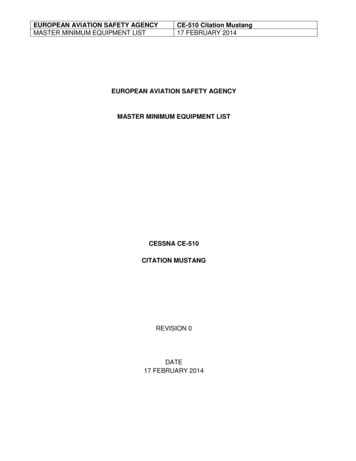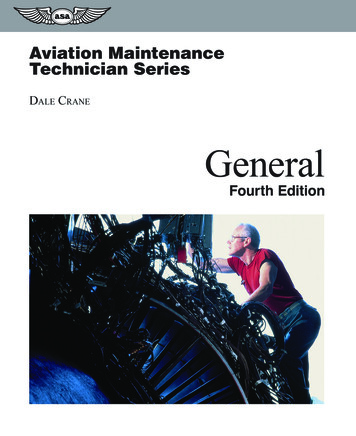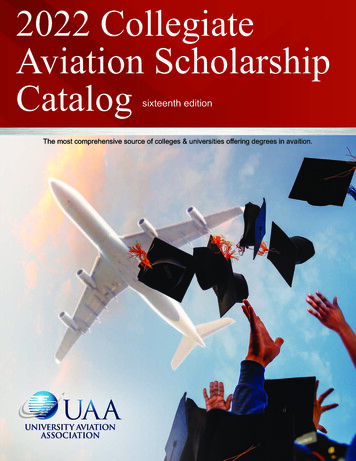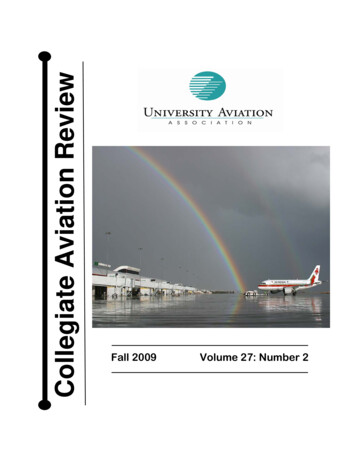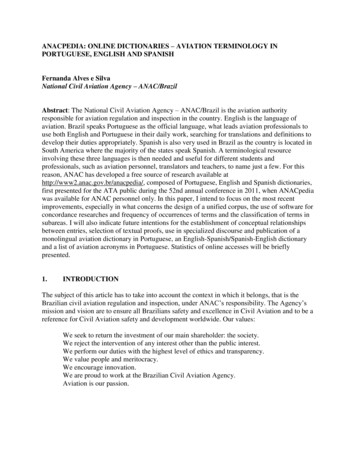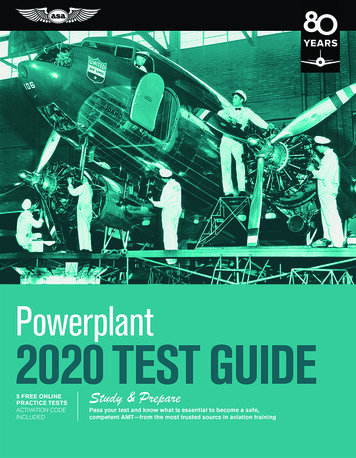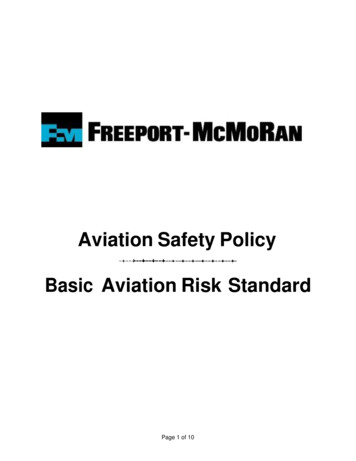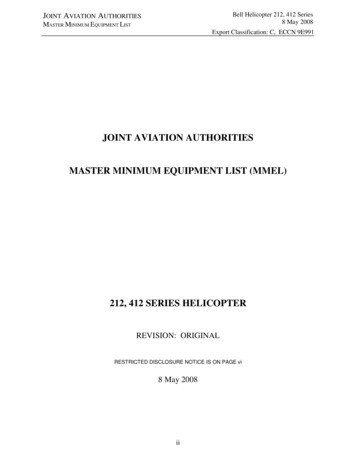
Transcription
Bell Helicopter 212, 412 Series8 May 2008JOINT AVIATION AUTHORITIESMASTER MINIMUM EQUIPMENT LISTExport Classification: C, ECCN 9E991JOINT AVIATION AUTHORITIESMASTER MINIMUM EQUIPMENT LIST (MMEL)212, 412 SERIES HELICOPTERREVISION: ORIGINALRESTRICTED DISCLOSURE NOTICE IS ON PAGE vi8 May 2008ii
Bell Helicopter 212, 412 Series8 May 2008JOINT AVIATION AUTHORITIESMASTER MINIMUM EQUIPMENT LISTExport Classification: C, ECCN 9E991RESTRICTED DISCLOSURE NOTICEDRAWINGS, SPECIFICATIONS, DESCRIPTIONS, AND OTHER TECHNICAL DATAATTACHED HERETO ARE PROPRIETARY AND CONFIDENTIAL TO BELL ANADALTD.ANDCONSTITUTE TRADE SECRETS FOR PURPOSES OF THE TRADE SECRET ANDFREEDOM OF INFORMATION ACTS. NO DISCLOSURE TO OTHERS, EITHER IN THEUNITED STATES, CANADA OR ABROAD OR REPRODUCTION OF ANY PART OF THEINFORMATION SUPPLIED IS TO BE MADE, AND NO MANUFACTURE, SALE OR USE OFANY INVENTION OR DISCOVERY DISCLOSED HEREIN SHALL BE MADE, EXCEPT BYWRITTEN AUTHORIZATION OF BELL HELICOPTER TEXTRON INC. OR BELLHELICOPTER TEXTRON CANADA LTD.THIS NOTICE WILL NOT OPERATE TONULLIFY OR LIMIT RIGHTS GRANTED BY CONTRACT. THE DATA SUBJECT TO THISRESTRICTION IS CONTAINED IN ALL SHEETS AND IS DISCLOSED TO PERSONNEL OFBELL HELICOPTER TEXTRON INC., AND BELL HELICOPTER TEXTRON CANADA LTD.FOR THE PURPOSE(S) OF INTERNAL USE AND DISTRIBUTION ONLY. 2007 Bell Helicopter Textron Inc.and Bell Helicopter Textron Canada LimitedUNPUBLISHED - ALL RIGHTS RESERVEDiv
Bell Helicopter 212, 412 Series8 May 2008JOINT AVIATION AUTHORITIESMASTER MINIMUM EQUIPMENT LISTExport Classification: C, ECCN 9E991RevSectionDateREVISION RECORD / REASONByCheckedApprovedDescriptionvUse or disclosure of data contained on this sheet is subject to the restriction on the title page of this document.Approved
Bell Helicopter 212, 412 Series8 May 2008JOINT AVIATION AUTHORITIESMASTER MINIMUM EQUIPMENT LISTExport Classification: C, ECCN 9E991TABLE OF CONTENTSParagraphPageREVISION RECORD / REASON.vTABLE OF CONTENTS. viLIST OF EFFECTIVE PAGES . viiACRONYM LIST. viiiPREAMBLE .1DEFINITIONS AND EXPLANATORY NOTES.3MASTER MINIMUM EQUIPMENT LIST.7Air Conditioning . 21-1Auto Flight . 22-1Communications . 23-1Electrical Power . 24-1Equipment / Furnishings . 25-1Fire Protection. 26-1Flight Controls . 27-1Fuel . 28-1Ice and Rain Protection. 30-1Indicating/Recording . 31-1Lights . 33-1Navigation. 34-1Oxygen. 35-1HUMS . 45-1Doors . 52-1Rotors . 65-1Engine Fuel and Control . 73-1Engine Indication . 77-1Engine Oil . 79-1APENDIX A .47viUse or disclosure of data contained on this sheet is subject to the restriction on the title page of this document.
Bell Helicopter 212, 412 Series8 May 2008JOINT AVIATION AUTHORITIESMASTER MINIMUM EQUIPMENT LISTExport Classification: C, ECCN 9E991LIST OF EFFECTIVE PAGESPageAllRevisionInitial ReleaseviiUse or disclosure of data contained on this sheet is subject to the restriction on the title page of this document.Date
Bell Helicopter 212, 412 Series8 May 2008JOINT AVIATION AUTHORITIESMASTER MINIMUM EQUIPMENT LISTExport Classification: C, ECCN 9E991Acronym tomatically Deployable Emergency Locator TransmitterAutomatic Direction FinderAutomatic Flight Control SystemAircraft Flight ManualAir Transport AssociationAir Traffic ControlCivil Aviation AuthorityCockpit Voice RecorderCaution Warning PanelDistance Measuring EquipmentEuropean Aviation Safety AgencyEmergency Locator TransmitterEmergency Medical SystemFederal Aviation AdministrationFederal Airworthiness RegulationsFlight Data RecorderFlight ManualHelicopter Emergency Egress Lighting SystemHigh FrequencyHealth Usage Monitoring SystemInter Communication SystemInstrument Flight RulesInstrument Landing SystemJoint Aviation AuthoritiesJoint Airworthiness Regulation Operational Specification'sLight Emitting DiodeManufacturing EngineerMinimum Equipment ListMaster Minimum Equipment ListOutside Air TemperatureOperational Evaluation BoardPublic AddressRotorcraft Flight ManualRevolutions Per MinuteTraffic Collision Alert DeviceTraffic Collision Alert SystemTemporary Guidance LeafletUniversal Coordinated TimeUltra High FrequencyVisual Flight RulesVery High FrequencyVisual Meteorological ConditionsVHF Omni directional RangeVertical Speed IndicatorviiiUse or disclosure of data contained on this sheet is subject to the restriction on the title page of this document.
Bell Helicopter 212, 412 Series8 May 2008JOINT AVIATION AUTHORITIESMASTER MINIMUM EQUIPMENT LISTExport Classification: C, ECCN 9E991INTENTIONALLY LEFT BLANKixUse or disclosure of data contained on this sheet is subject to the restriction on the title page of this document.
Bell Helicopter 212, 412 Series8 May 2008JOINT AVIATION AUTHORITIESMASTER MINIMUM EQUIPMENT LISTExport Classification: C, ECCN 9E991JOINT AVIATION AUTHORITIES212, 412 SERIES Master Minimum Equipment List (MMEL)PREAMBLEThe following is applicable for authorized certificate holders operating under Authorities OperatingRequirements (JAR-OPS). The JAR require that all equipment installed on an aircraft in compliance with theAirworthiness Standards and the Operational Requirements must be operative. However, the requirements alsopermit the publication of a Minimum Equipment List (MEL) where compliance with certain equipmentrequirements is not necessary in the interest of safety under all operating conditions. Experience has shown thatwith the various levels of redundancy designed into aircraft, operation of every system installed or componentmay not be necessary when the remaining operative equipment can provide an acceptable level of safety.The Master Minimum Equipment List (MMEL) is developed by the Type Certificate Holder and recommendedfor approval by the OEB to the JAA Member Authorities to improve aircraft utilization and thereby providemore convenient and economic air transportation for the public. The JAA MMEL includes those items ofequipment related to airworthiness and Operational Requirements and other items of equipment which JAAfinds may be inoperative and yet maintain an acceptable level of safety by appropriate conditions andlimitations; it does not contain obviously required items such as rotor blades, stabilizer and engines.The MMEL Is the basis for development of individual operator’s MELs which take into consideration theoperator’s particular aircraft equipment configuration and operational conditions. An operator’s MEL maydiffer in format from the MMEL, but cannot be less restrictive than the MMEL. The individual operator’sMEL, when approved permits operation of the aircraft with inoperative equipment.Equipment not required by the operation being conducted and equipment in excess of EASA requirements areincluded in the MEL with appropriate conditions and limitations. The ME must not deviate from AirworthinessDirectives or any other Mandatory Requirement. It is important to remember that all equipment related to theairworthiness and the Operational Requirements of the aircraft not listed on the MMEL must be operative.Suitable conditions and limitations in the form of placards, maintenance procedures, crew operating proceduresand other restrictions as necessary are specified in the MEL to ensure that an acceptable level of safety ismaintained.The MEL is intended to permit operation with inoperative items of equipment for a period of time untilrectification’s can be accomplished. It is important that rectifications be accomplished at the earliestopportunity. In order to maintain an acceptable level of safety and reliability the MMEL establishes limitationon the duration of and conditions for operation with inoperative equipment. The MEL provides for release ofthe aircraft for flight with inoperative equipment.When an item of equipment is discovered to be inoperative, it is reported by making an entry in the AircraftMaintenance Record/Logbook as prescribed by JAR. The item is then either rectified or may be deferred perthe MEL or other approval means acceptable to the competent Authority prior to further operation. MELconditions and limitation do not relieve the operator from determining that the aircraft is in a condition for safeoperation with items of equipment inoperative.When these requirements are met, an Airworthiness1Release, Aircraft Maintenance Record/Logbook entry,Use or disclosure of data contained on this sheet is subject to the restriction on the title page of this document.
Bell Helicopter 212, 412 Series8 May 2008JOINT AVIATION AUTHORITIESMASTER MINIMUM EQUIPMENT LISTExport Classification: C, ECCN 9E991or other approved documentation is issued as prescribed by JAR. Such documentation is required prior tooperation with any item of equipment inoperative.Operators are responsible for exercising the necessary operational control to ensure that an acceptable level ofsafety is maintained. The exposure to additional failures during continued operation with inoperative system orcomponents must also be considered. Wherever possible account has been taken in this MMEL of multipleinoperative items. However, it is unlikely that all possible combinations of this nature have been accounted for.Therefore, when operating with multiple inoperative items, the inter-relationships between those items and theeffect on aircraft operation and crew workload must be considered.Operators are to establish a controlled and sound rectification program including the parts, personnel, facilities,procedures and schedules to ensure timely rectification. This program should identify the actions required forMaintenance discrepancy messages.WHEN USING THE MEL, COMPLIANCE WITH THE STATED INTENT OF THE PREAMBLE,DEFINITIONS AND THE CONDITIONS AND LIMITATIONS SPECIFIED IN THE MEL IS REQUIRED.2Use or disclosure of data contained on this sheet is subject to the restriction on the title page of this document.
Bell Helicopter 212, 412 Series8 May 2008JOINT AVIATION AUTHORITIESMASTER MINIMUM EQUIPMENT LISTExport Classification: C, ECCN 9E991DEFINITIONS AND EXPLANATORY NOTESThe definition(s) presented here are additional to any which are otherwise applicable:System Definitions.1) In this list, the items of equipment are classified in systems according to the ATA 100 specification.Individual items within a given ATA classification are numbered sequentially.2) "Item" (Column 1) means the equipment, system, component, or function listed in the "Item" column.3) “(if installed)”: Indicates the listed item of equipment is not applicable to all models or configurations. Itdoes not imply that the aircraft may be operated in accordance with this MMEL with the item removed.4) Items annotated in UPPER CASE letters indicate the precise flight deck legend used.5)“Rectification Intervals” (column 2): the following definitions are used throughout this document:Category A. Items in this category shall be rectified in accordance with the conditions stated in theRemarks column (5) of the MMEL.Category B. Items in this category shall be repaired within three (3) consecutive calendar days (72hours); excluding the day the malfunction was recorded in the aircraft maintenance record/logbook. Forexample, if it were recorded at 10 a.m. on January 26th, the three day interval would begin at midnightthe 26th and end at midnight the 29th.Category C. Items in this category shall be repaired within ten (10) consecutive calendar days (240hours); excluding the day the malfunction was recorded in the aircraft maintenance record/logbook. Forexample, if it were recorded at 10 a.m. on January 26th, the 10 day interval would begin at midnight the26th and end at midnight February 5th.Category D. Items in this category shall be repaired within one hundred and twenty (120) consecutivecalendar days (2880 hours); excluding the day the malfunction was recorded in the aircraft maintenancelog and/or record.6) "Number Installed" (Column 3) is the number (quantity) of items normally installed in the aircraft. Thisnumber represents the aircraft configuration considered in developing this MMEL. Should the number be avariable (e.g., passenger cabin items) a number is not required.7) "Number Required for Dispatch" (Column 4) is the minimum number (quantity) of items required foroperation provided the conditions specified in Column 5 are met. Where the MMEL shows a variablenumber required for dispatch, the MEL must reflect the actual number required for dispatch or an alternatemeans of configuration control approved by the Administrator.8) "Remarks or Exceptions" (Column 5): This column includes a statement either prohibiting or permittingoperation with a specific number of items inoperative, provisos (conditions and limitations) for suchoperation, and appropriate notes.3Use or disclosure of data contained on this sheet is subject to the restriction on the title page of this document.
Bell Helicopter 212, 412 Series8 May 2008JOINT AVIATION AUTHORITIESMASTER MINIMUM EQUIPMENT LISTExport Classification: C, ECCN 9E991A note in column 5 indicates additional information and references for crew and/or maintenance personnelconsideration; they are not part of the provisos.Where references are stated in column 5 theses are to identify certain inter-relationships between the subjectitem and other MMEL items, AFM material etc. These references are intended to assist, but not relieve, anoperator of the responsibility for determining such inter-relationships as stated in the Preamble.9) Dash "-" : This symbol in Column 3 and/or Column 4 indicates a variable number (quantity) of the item.10) "Inoperative": A system and/or component malfunction to the extent that it does not accomplish itsintended purpose and/or is not consistently functioning normally within its approved operating limit(s) ortolerance(s).11) "(M)": The use of this symbol indicates a requirement for a specific maintenance procedure which must beaccomplished prior to operation with the listed item inoperative. Normally these procedures areaccomplished by maintenance personnel; however, other personnel may be qualified and authorized toperform certain functions. Procedures requiring specialized knowledge or skill, or requiring the use of toolsor test equipment should be accomplished by maintenance personnel. The satisfactory accomplishment ofall maintenance procedures, regardless of who performs them, is the responsibility of the operator.Appropriate procedures are required to be published as part of the operator's manual or MEL.12) "(O)" : The use of this symbol indicates a requirement for a specific operations procedure which must beaccomplished in planning for and/or operating with the listed item inoperative. Normally these proceduresare accomplished by the flight crew; however, other personnel may be qualified and authorized to performcertain functions. The satisfactory accomplishment of all procedures, regardless of who performs them, isthe responsibility of the operator. Appropriate procedures required to be published as a part of theoperator's manual or MEL.13) "Rotorcraft Flight Manual" (RFM) is the document required for type certification and approval by EASA14) As required by Operational Requirements: The associated item must comply with JAR-OPS 3 or any otherlegislation in force during the flight. Operators should refer to JAR-OPS 3 MEL Policy Document(Administrative and Guidance Material, Section Four: Operations, Part Three: Temporary Guidance Leafletnumber 26) for suitable alleviations based upon the required equipment identified within JAR-OPS 3,subparts K and L.15) Each inoperative item must be placarded to inform and remind the crewmembers and maintenancepersonnel of the equipment condition. To the extent practical, placards should be located adjacent to thecontrol or indicator for the item affected; however, unless otherwise specified, placard wording and locationwill be determined by the operator.16) "Deleted": When in the remarks column after a sequence item indicates that the item was previously listedbut is now required to be operative if installed in the helicopter.17) "Flight Day": A 24 hour period (from midnight to midnight) either Universal Coordinated Time (UCT) orlocal time, as established by the operator, during which at least one flight is initiated for the affectedaircraft.4Use or disclosure of data contained on this sheet is subject to the restriction on the title page of this document.
Bell Helicopter 212, 412 Series8 May 2008JOINT AVIATION AUTHORITIESMASTER MINIMUM EQUIPMENT LISTExport Classification: C, ECCN 9E99118) “Flight Hour”: The time from the moment a helicopter leaves the surface of the earth until it touches it atthe next point of landing.19) “Flight”: For the purpose of a MEL, a flight is the period of time between the moment when a helicopterbegins to move by its own means, for the purpose of preparing for take-off, until the moment the helicoptercomes to a complete stop on its parking area, after the subsequent landing (and no subsequent take-off).20) "Icing Conditions": An atmospheric environment that may cause ice to form on the aircraft or in theengine(s).21) Inoperative components of an inoperative system: Inoperative items which are components of a systemwhich is inoperative are usually considered components directly associated with and having no otherfunction than to support that system. (Warning/caution systems associated with the inoperative system mustbe operative unless relief is specifically authorized per the MMEL).22) "Deactivated" and "Secured" means that the specified component must be put into an acceptable conditionfor safe flight. An acceptable method of securing or deactivating will be established by the operator.23) "Visual Flight Rules" (VFR): is as defined in the JARS. This precludes a pilot from filing an InstrumentFlight Rules (IFR) flight plan.24) Visual Meteorological Conditions" (VMC) are meteorological conditions in terms of visibility, distancefrom cloud, and ceiling, equal to or better than the minima specified in Appendix 1 to JAR-OPS 3.465. Thisdefinition does not include ‘VFR-on-Top’ or ‘over-the-top’.25) "Visible Moisture" means an atmospheric environment containing water in any form that can be seen innatural or artificial light; for example, clouds, fog, rain, sleet, hail, or snow.26) “Adequate External Attitude Reference” is defined as meteorological conditions and visual cues thatpermit the helicopter attitude and flight path to be determined without sole reference to instruments.27) Extended Over water Flight: Refer to JAR-OPS 3 Subpart K for definition.28) "Passenger Convenience Items" means those items related to passenger convenience, comfort orentertainment such as, but not limited to, galley equipment, movie equipment, ash trays, stereo equipment,overhead reading lamps, etc.29) "Excess Items" means those items that have been installed that are redundant to the requirements of theOperating Requirements.30) “Authority”: The competent regulatory authority according to the country of registry.31) “Combustible (Material)”: refers to material which is capable of catching fire and burning. In particular:if a MMEL item prohibits loading of combustible (or flammable or inflammable) material, no material maybe loaded except the following:5Use or disclosure of data contained on this sheet is subject to the restriction on the title page of this document.
Bell Helicopter 212, 412 Series8 May 2008JOINT AVIATION AUTHORITIESMASTER MINIMUM EQUIPMENT LISTExport Classification: C, ECCN 9E9911) Cargo handling equipment (unloaded, empty or with ballast);2) Fly away kits (excluding e.g. cans of hydraulic fluid, cleaning solvents, batteries, capacitors, chemicalgenerators, etc.); and3) In-flight service material (return catering – only closed catering trolley/boxes, no newspapers, no alcoholor duty free goods).32) “System”: System means the group of directly related components which together perform a specifiedfunction, for example “RPM Indication System” would include the RPM Indicator, tachometer generator,circuit breaker and associated circuitry.33) “Dispatch”: The point at which an aircraft first moves under its own power for the purpose of commencinga flight.34) “Day of Discovery”: is the calendar day an equipment/instrument malfunction was recorded in thehelicopter maintenance log and or record. This day is excluded from the calendar days or flight daysspecified in the MMEL for the repair of an inoperative item of equipment. This provision is applicable toall MMEL items, i.e., categories “A, B, C and D.”35) “Considered Inoperative”: as used in the provisions means than item must be treated for dispatch, taxi andflight purposes as though it were inoperative. The item shall not be used or operated until the originaldeferred item is repaired. Additional actions include: complying with all remarks, exceptions, and relatedMMEL provisions, including any (M) and (O) procedures and observing the repair category.36) “(where required)”: Indicates the equipment, system, component, or function listed in the “Item” columnmay not be required as defined by JAR-OPS.37) The base documents used for the preparation of this MMEL are:a) FAA approved MMEL Bell Helicopter 212, 412 Series Revision 7 dated 02/06/2006b) CAA approved MMEL Bell Helicopter 212, 412 Revision 1 dated Rev 31/10/1995c) JAA TGL 26 dated 01/06/2007Note that the item numbering arrangement for the FAA MMEL was maintained for continuity.38) “Not Used”: An item number that appeared in the base document (e.g. FAA MMEL) that had been deleted.6Use or disclosure of data contained on this sheet is subject to the restriction on the title page of this document.
Bell Helicopter 212, 412 Series8 May 2008JOINT AVIATION AUTHORITIESMASTER MINIMUM EQUIPMENT LISTExport Classification: C, ECCN 9E991212, 412 SERIES MMEL7Use or disclosure of data contained on this sheet is subject to the restriction on the title page of this document.
Bell Helicopter 212, 412 Series8 May 2008JOINT AVIATION AUTHORITIESMASTER MINIMUM EQUIPMENT LISTExport Classification: C, ECCN 9E991Bell Helicopter 212, 412 SeriesRevision No. -Page:Date: 05/08/2008(1) System & Sequence Numbers(2)ATA 21 AIR CONDITIONINGRectification Interval(3)Number Installed(4)ITEM1.2) Two Pilot Operations2.Number Required for Dispatch(5)Cockpit Vent Blowers1) Single Pilot OperationsBleed Air Heater1) Single Pilot Operations21-1Remarks or ExceptionsC21Co-Pilot’s may be inoperative.C20Both may be inoperative provided Pilot’s HeatedWindshield (Item 30-4) is installed and operative.C20Both may be inoperative provided Bleed AirHeater (Item 21-2) is operative.C20Both may be inoperative provided HeatedWindshields (Item 30-4) are installed for bothpilots and operative.C20Both may be inoperative provided Bleed AirHeater (item 21-2) is operative.C10C10.May be inoperative provided;(a) Heater switch is selected OFF,(b) Outside air temperature is above 5 degreesC and,(c) Pilot’s cockpit vent blower (Item 21-1) isoperativeMay be inoperative may be inoperative providedpilot’s Heated Windshield (Item 30-4) is installedand operative.3.Bleed Air Cooling System(if installed)C-0(M) May be inoperative provided system isdeactivated and secured.4.Freon Cooling System(if installed)C-0(M) May be inoperative provided system isdeactivated and secured.8Use or disclosure of data contained on this sheet is subject to the restriction on the title page of this document.
Bell Helicopter 212, 412 Series8 May 2008JOINT AVIATION AUTHORITIESMASTER MINIMUM EQUIPMENT LISTExport Classification: C, ECCN 9E991Aircraft:Revision No. Bell Helicopter 212, 412 Series(1) System & Sequence Numbers(2)ATA 22 AUTOPILOTDate: 05/08/2008(3)Number InstalledITEM2.Flight Director(if installed)Number Required for Dispatch(5)Automatic Flight Control Systems(AFCS)(JAR-OPS 3.655)(1) Single pilot operations22-1Rectification Interval(4)1.Page:Remarks or ExceptionsC-0One or more may be inoperative provided theflight is conducted under day VMCD-1Any in excess of one may be inoperative.C-0(O) May be wholly or partially inoperativeprovided precision navigation or approach minimado not require their use.9Use or disclosure of data contained on this sheet is subject to the restriction on the title page of this document.
Bell Helicopter 212, 412 Series8 May 2008JOINT AVIATION AUTHORITIESMASTER MINIMUM EQUIPMENT LISTExport Classification: C, ECCN 9E991Bell Helicopter 212, 412 SeriesRevision No. -Page:Date: 05/08/2008(1) System & Sequence Numbers(2)ATA 23 COMMUNICATIONSRectification Interval(3)Number Installed(4)ITEM1.Number Required for Dispatch(5)Radio Communications Systems(FM, HF, UHF, VHF, etc.)(JAR-OPS 3.860/865)2. (1) Cockpit Voice Recorder (CVR)(212, 412, 412SP) (if installed)23-1Remarks or ExceptionsC-1When flying VFR over routes navigated byreference to visual landmarks: Any in excess ofone, and not power by an emergency bus, may beinoperative.A-1(O) When flying IFR, or VFR over routes notnavigated by reference to visual landmarks: Anyone of the two required Radio CommunicationSystems not powered by the emergency bus maybe inoperative provided:(a) The helicopter has not made more than oneflight since the item was last serviceable, and(b) The commander has satisfied himself that,taking into account the latest informationavailable as to the route/are and heliport to beused (including any planned diversion) and theweather conditions likely to be encountered ,the flight can be made safely and in accordancewith any relevant requirements of theappropriate air traffic control unit.D10May be inoperative.10Use or disclosure of data contained on this sheet is subject to the restriction on the title page of this document.
Bell Helicopter 212, 412 Series8 May 2008JOINT AVIATION AUTHORITIESMASTER MINIMUM EQUIPMENT LISTExport Classification: C, ECCN 9E991Bell Helicopter 212, 412 SeriesRevision No. -Page:Date: 05/08/2008(1) System & Sequence Numbers(2)ATA 23 COMMUNICATIONSRectification Interval(3)Number Installed(4)ITEMNumber Required for Dispatch(5)2. (2) Cockpit Voice Recorder (CVR)(412 HP, 412EP)(JAR-OPS 3.705)A23-210Remarks or ExceptionsMay be inoperative provided:a) The helicopter does not exceed 8 furtherflights with the CVR inoperative.b) A maximum of 72 hours have elapsed sincethe CVR was found to be inoperative, and,c) Any Flight Data Recorder (FDR) required tobe carried is operative,Note: This alleviation is not applicable tocombined CVR/FDRs. For those combinedsystems, refer to item 31-6.3.Flight Data Recorder (FDR)4.Cabin Public Address SystemSee ATA 31.(JAR-OPS 3.695)1) Passenger config. (IncludingPre-recorded PassengerAnnouncement System)B-0(O) May be inoperative provided:(a) Alternate normal and emergency proceduresand/or operating r
hours); excluding the day the malfunction was recorded in the aircraft maintenance record/logbook. For example, if it were recorded at 10 a.m. on January 26th, the three day interval would begin at midnight the 26th and end at midnight the 29th. Category C. Items in this category shall be repaired within ten (10) consecutive calendar days (240
